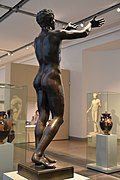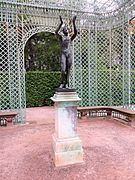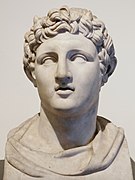Berlin Adorant

The Praying Boy (in German, Der betende Knabe), also known as the Berlin Adorant, is an Ancient Greek bronze statue of a naked male youth with arms raised, which stands 128 cm (50 in) high, at or perhaps slightly smaller than life size. Sculpted in a Hellenistic style, it is dated to c.300BC, and attributed to the school of Lysippos. It is held by the Altes Museum in Berlin.
The incomplete bronze statue, initially missing arms and legs, was found on the island of
It was sold to King
Numerous repairs have been required over the last 500 years, including replacement of parts of the feet and toes. The position of the restored arms has led to the interpretation of the statue as praying, but no interpretation is universally accepted. It has suggested that the statue may represent Apollo or Ganymede, or perhaps an athlete or a shepherd. It may have formed part of a larger sculptural group.
Metallurgical analysis indicates the statue was made in the Hellenistic period. Stylistic similarities to a bust of Demetrius I of Macedon in Naples indicates the statue may have been made by Teisikrates, a grandson of Lysippos, around 300BC. Others attribute it to Boidas, a son of Lysippos, relying on a reference to a statue of a praying boy mentioned in Pliny's Natural History.
-
rear view
-
copy on display at Sansoussi
-
Roman copy of a Greek bust of Demetrius I of Macedon
References
- Bronzestatue eines jungen Mannes (sog. Betender Knabe), Staatliche Museen zu Berlin
- The “praying boy”, Google Arts & Culture
- The Adventurous Life of the ‘Betende Knabe’, Leverhulme Trust
- Praying Boy, Museum of Classical Archaeology Databases, University of Cambridge



